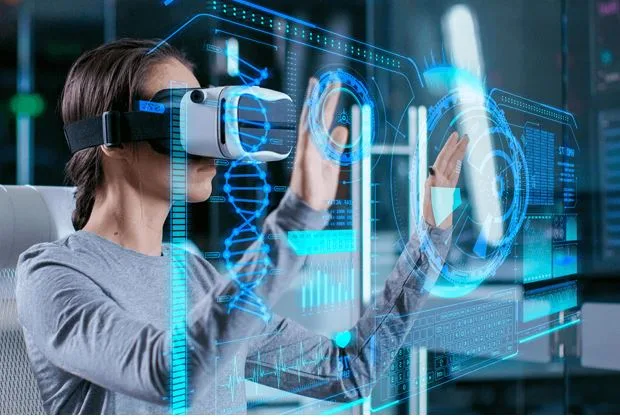Augmented Reality (AR) Training: Bridging the Gap Between Digital and Physical Worlds
While Virtual Reality creates entirely new digital environments, Augmented Reality enhances the real world by overlaying computer-generated information onto a user’s view. AR technology integrates digital content—such as images, 3D models, and instructional text—with the user’s physical surroundings in real-time. This is typically accomplished through devices like smartphones, tablets, or specialized AR glasses. For corporate training, AR serves as a powerful performance support tool, providing employees with immediate, context-aware guidance directly within their workflow.
The primary distinction between VR and AR lies in the level of immersion. VR isolates the user from their physical environment to create a complete simulation, making it ideal for practicing complex scenarios or soft skills in a controlled setting. AR, conversely, keeps the user grounded in their actual workspace while providing digital assistance. This makes it exceptionally effective for on-the-job training, task guidance, and knowledge reinforcement.
The benefits of integrating AR into training strategies are substantial:
- Improved Efficiency and Accuracy: By providing real-time, step-by-step instructions, AR helps employees perform complex tasks more quickly and with fewer errors. Technicians can view digital overlays on machinery to identify parts or follow repair sequences, reducing cognitive load and reliance on paper manuals.
- Enhanced Knowledge Transfer: AR facilitates “just-in-time” learning, delivering information precisely when and where it is needed. This immediate application of knowledge significantly improves retention and helps bridge the skills gap, especially for new or less experienced employees.
- Increased Safety: In hazardous environments, AR can highlight potential dangers, display safety protocols, and guide employees through complex procedures without them needing to look away from their work to consult a guide. This continuous situational awareness is critical for preventing accidents.
- Accessibility and Scalability: A major advantage of AR is that it can often be deployed on existing hardware that employees already own, such as smartphones and tablets. This lowers the barrier to entry and makes it easier to scale AR training solutions across a large and geographically dispersed workforce.
AR is also highly effective for delivering microlearning modules. These short, focused bursts of content are designed to teach a specific skill or concept. An employee can quickly access an AR module on their device to learn how to operate a new piece of equipment or troubleshoot a common problem, making learning a seamless part of their daily work.
Practical Applications of AR in Corporate Training
The versatility of Augmented Reality Training has led to its adoption across a wide range of industries, with organizations leveraging the technology to solve specific business challenges and improve operational performance.
- Manufacturing and Assembly: Companies like Boeing and Mercedes-Benz have been pioneers in using AR to streamline complex assembly processes. Assembly line workers equipped with AR glasses can see holographic instructions, placement guides, and torque specifications projected directly onto their workstation. This has resulted in significant reductions in assembly time and error rates, leading to improved production quality and efficiency.
- Maintenance and Repair: AR is transforming field service and maintenance operations. A technician repairing a complex piece of industrial equipment can use an AR application on a tablet to see a digital overlay of the machine’s internal components. The application can guide them through the entire repair process, from diagnosis to reassembly. Furthermore, AR enables “see-what-I-see” remote assistance, where a junior technician can stream their view to a senior expert who can then provide real-time guidance by annotating the live video feed.
- Logistics and Warehousing: In large distribution centers, AR applications guide warehouse workers to the correct locations for order picking. Visual cues displayed through AR glasses can highlight the specific items to be picked and indicate the optimal route through the warehouse, improving picking speed and accuracy while reducing training time for new staff.
- Retail: Retail employees can use AR-enabled devices to access instant product information, check inventory levels, and view customer reviews simply by pointing their device’s camera at a product on the shelf. This empowers them to provide better customer service. AR can also be used to train staff on visual merchandising standards by showing them exactly how product displays should be arranged.
- Healthcare: In the medical field, AR has profound implications for both training and practice. Medical students can use AR to visualize and interact with 3D anatomical models, gaining a deeper understanding of the human body. During surgery, surgeons can use AR to overlay a patient’s CT scans or MRI data onto their field of view, providing critical information and improving surgical precision.
The Future of Corporate Training is Immersive and Data-Driven
The advancement of corporate learning is not solely about adopting individual technologies like VR or AR. The true transformation lies in creating an integrated learning ecosystem where these immersive tools are combined with data analytics and artificial intelligence (AI) to deliver personalized, adaptive, and highly effective training experiences.
The next generation of training solutions will move beyond one-size-fits-all programs. By leveraging data captured during VR and AR training sessions—such as gaze tracking, decision-making patterns, and task completion times—organizations can gain unprecedented insight into individual learner performance. Learning platforms can use this data to identify skill gaps and automatically recommend personalized training modules to address specific areas for improvement. AI algorithms can further enhance this by creating adaptive learning paths that adjust in real-time based on a learner’s progress.
The convergence of physical and digital worlds will continue with the growth of Mixed Reality (MR), which allows users to interact with digital objects as if they were real. Imagine an engineering team collaborating on a 3D prototype of a new product in a shared holographic space, or a manager providing real-time feedback to an employee practicing a difficult conversation with an AI-powered virtual human.
The addition of haptic technology, which provides tactile feedback, will further heighten the realism of immersive experiences. Trainees will be able to feel the vibration of a tool, the texture of a material, or the resistance of a virtual object, making simulations even more convincing and effective for developing muscle memory and fine motor skills.
Implementing VR and AR Training: A Strategic Approach
Adopting immersive technologies requires a thoughtful and strategic approach. Organizations that simply purchase headsets without a clear plan are unlikely to see a significant return on their investment. A successful implementation involves several key steps:
- Identify a Specific Business Need: Begin by identifying a clear and pressing business problem that VR or AR can solve. This could be a high rate of safety incidents, a long ramp-up time for new hires, or a need to improve the quality of customer interactions. Focusing on a specific use case with measurable outcomes will help build a strong business case for the investment.
- Select the Appropriate Technology: The choice between VR, AR, or a blended solution depends entirely on the learning objectives. For complex, scenario-based training that requires full immersion and a safe space to fail, VR is often the best choice. For on-the-job performance support and procedural guidance, AR is typically more suitable.
- Prioritize High-Quality Instructional Design: Technology is only a tool; the effectiveness of the training ultimately depends on the quality of the content. It is crucial to partner with instructional design experts who understand how to create engaging and effective learning experiences specifically for immersive environments. Off-the-shelf content may not align with your organization’s unique processes and culture, so custom content development is often necessary.
- Launch a Pilot Program: Before a full-scale rollout, launch a pilot program with a small group of learners. This allows you to test the technology, gather feedback on the content, and measure the initial impact. The insights gained from the pilot can be used to refine the program and ensure a successful organization-wide implementation.
- Develop a Scalability Plan: Consider how you will manage and distribute the hardware, deploy the software, and train employees on how to use the new technology. A robust learning platform that can track usage, manage content, and measure performance analytics is essential for scaling an immersive training program effectively.
The evolution of corporate training is moving towards more interactive, engaging, and effective methods. VR and AR are at the forefront of this shift, offering powerful new ways to build a more skilled, confident, and resilient workforce. By embracing these technologies strategically, organizations can not only address their current training challenges but also prepare their employees for the demands of the future.





